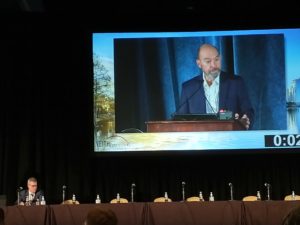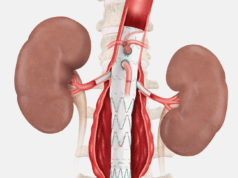
The confirmatory EVAS2 clinical study to evaluate the safety and effectiveness of Endologix’s Nellix endovascular aneurysm sealing system (EVAS) for the treatment of infrarenal abdominal aortic aneurysms (AAAs) contains positive two-year follow-up data, the leading investigator has revealed.
A first study update was presented by principal investigator Jeffrey Carpenter, MD, chairman and chief of the department of surgery at Cooper University Health Care in Camden, New Jersey, at the 2021 VEITHsymposium (Nov. 16–20) in Orlando, Florida.
Carpenter told delegates data from two years of follow-up of patients treated with the EVAS device demonstrate 92% freedom from all-cause mortality, 100% freedom from migration, 100% freedom from saccular enlargement, 98% freedom from type Ia endoleaks, and 98% freedom from type II endoleaks. “We’re only at two years of good follow-up,” Carpenter said, explaining that this was the point at which “the signal of problems” emerged in EVAS1. However, he said the study investigators were hopeful of success in the current study as they continue to follow study participants, with data “holding up.”
Carpenter explained that at two years of follow-up in the device’s pivotal investigational device exemption (IDE) trial, “there was a signal of migration and a signal of aneurysm enlargement development.” A root-cause analysis found that thrombus “was playing a big role” in the case of migration, he told VEITH 2021 attendees. Regarding aneurysm enlargement, Carpenter continued, “we were originally employing what turns out to be a plug,” under an understanding that they only needed to fill the aneurysmal portion of the aorta with polymer—but not the seal zones, or “firewalls.” Adjustments were made, resulting in “a revision of the instructions for use (IFU) to make sure that there was able to be sufficient polymer placed into the aneurysm sac to stabilize the stents and that we had good seal zones proximally and distally,” he said.
In 2019, Endologix issued a voluntary recall for the EVAS system in order to ensure optimal patient outcomes through the most appropriate use of the device, with the company noting that it had determined off-label use was occurring at “an unacceptable level, with the consequence of suboptimal results.”
The 333 patients in EVAS1 retrospectively yielded the device IFU, Carpenter explained. Those in this group treated on-label experienced 97% freedom from migration, he added. EVAS2 consists of 92 patients and is an IDE prospective, multicenter, single-arm study with consecutive, eligible subject enrollment at each site. Participants are being followed at 30 days (primary safety endpoint), six months, one year (primary effectiveness endpoint) and annually thereafter out to five years (total follow-up commitment).
Summarizing the EVAS2 data delivered at VEITH 2021, Carpenter concluded: “Active sac management of EVAS has shown good freedom from type II endoleak and freedom from all-cause and cardiovascular mortality in all quartiles. Clearly, a second-generation Nellix device is necessary if this is going to be an everyday infrarenal aneurysm repair device.” Data regarding five-year freedom from major adverse events are “encouraging,” he added.












